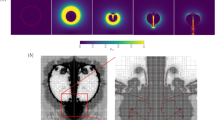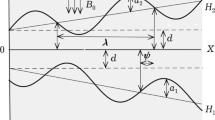Abstract
This paper reviews recent progress made toward modeling of cavitation and numerical simulation of cavitating water jets. Properties of existing cavitation models are discussed and a compressible mixture flow method for the numerical simulation of highspeed water jets accompanied by intensive cavitation is introduced. Two-phase fluids media of cavitating flow are treated as a homogeneous bubbly mixture and the mean flow is computed by solving Reynolds-Averaged Navier-Stokes (RANS) equations for compressible fluid. The intensity of cavitation is evaluated by the gas volume fraction, which is governed by the compressibility of bubble-liquid mixture corresponding to the status of mean flow field. Numerical results of cavitating water jet issuing from an orifice nozzle are presented and its applicability to intensively cavitating jets is demonstrated. However, the effect of impact pressure caused by collapsing of bubbles is neglected, and effectively coupling of the present compressible mixture flow method with the dynamics of bubbles remains to be a challenge.
Similar content being viewed by others
References
SHIMIZU S., PENG G. Water jetting technology for LOHAS[M]. Tokyo, Japan: International Academic Printing Co. Ltd., 2009, 294.
SOYAMA H., KUSAKA T. and SAKA M. Peening by the use of cavitation impacts for the improvement of fatigue strength[J]. Journal of Materials Science Letters, 2001, 20(13): 1263–1265.
SOYAMA H., TAKAKUWA O. Enhancing the aggressive strength of a cavitating jet and its practical application[ J]. Journal of Fluid Science and Technology, 2011, 6(4): 510–521.
YAMAGUTI A., SHIMIZU S. Erosion due to impingement of cavitation jet[J]. Journal of Fluids Engineering, 1987, 109(4): 442–447.
SOYAMA H., YANAUCHI Y. and SATO K. et al. High-speed observation of ultrahigh-speed submerged water jets[J]. Experimental Thermal and Fluid Science, 1996, 12(4): 411–416.
FOLDYNA J., SITEK L. and SVEHLA B. et al. Utilization of ultrasound to enhance high-speed water jet effects[J]. Ultrasonics Sonochemistry, 2004, 11(3): 131–137.
OOI K. K. Scale effects on cavitation inception in submerged water jets: A new look[J]. Journal of Fluid Mechanics, 1985, 151: 367–390.
GOPALAN G., KATZ J. and KNIO O. The flow structure in the near field of jets and its effect on cavitation inception[J]. Journal of Fluid Mechanics, 1999, 398: 1–43.
FRANC J. P., MICHEL J. M. Attached cavitation and the boundary layer: Experimental investigation and numerical treatment[J]. Journal of Fluid Mechanics, 1985, 154: 63–90.
LEMONNIER H., ROWE A. Another approach in modeling cavitation flows[J]. Journal of Fluid Mechanics, 1988, 195: 557–580.
SUSSMAN M. A second order coupled level set and volume-of-fluid method for computing growth and collapse of vapor bubbles[J]. Journal of Computational Physics, 2003, 187(1): 110–136.
YU P., CECCIO S. L. and TRYGGVASON G. The collapse of a cavitation bubble in shear flows -A numerical study[J]. Physics of Fluids, 1995, 7(11): 2608–2616.
GONCALVES E., PATELLA R. F. Numerical simulation of cavitating flows with homogeneous models[J]. Computers and Fluids, 2009, 38(9): 1682–1696.
SAUREL R., LEMETAYER O. A multiphase model for compressible flows with interfaces, shocks detonation waves and cavitation[J]. Journal Fluid Mechanics, 2001, 431: 239–271.
YANO T., EGASHIRA R. and FUJIKAWA S. Linear analysis of dispersive waves in bubbly flows based on averaged equations[J]. Journal of Physical Society of Japan, 2006, 75(10): 104401.
MATSUMOTO Y., YOSHIZAWA S. Behaviour of a bubble cluster in an ultrasound field[J]. International Journal of Numerical Methods in Fluids, 2004, 47(6): 591–601.
TAMURA Y., MATSUMOTO Y. Improvement of bubble model for cavitating flow simulations[J]. Journal of Hydrodynamics, 2009, 21(1): 41–46.
DELANNOY Y., KUENY J. Two phase flow approach in unsteady cavitation modeling[C]. Cavitation and multiphase flow forum. 1990, ASME FED-Vol. 98, 153–158.
IGA Y., NOHMI M. and GOTO A. et al. Numerical study of sheet cavitation breakoff phenomenon on a cascade hydrofoil[J]. Journal of Fluids Engineering, 2003, 125(4): 643–651.
KUBOTA A., KATO H. and YAMAGUTI H. A new modeling of cavitating flow: A numerical study of unsteady cavitation on a hydrofoil section[J]. Journal of Fluid Mechanics, 1992, 240: 59–96.
SINGHAL A. K., ATHAVALE M. M. and LI H. et al. Mathematical basis and validation of the full cavitation model[J]. Journal of Fluids Engineering, 2002, 124(3): 617–624.
KUNZ R. F., BOGER D. A. and STINEBRING D. R. et al. A preconditioned Navier-Stokes method for twophase flows with application to cavitation prediction[J]. Computers and Fluids, 2000, 29(8): 849–875.
HSIAO C. T., CHAHINE G. Prediction of tip vortex cavitation inception using coupled sphericaland nonspherical bubble models and Navier-Stokes computations[ J]. Journal of Marine Science and Technology, 2004, 8(3): 99–108.
SENOCAK I., SHYY W. A pressure-based method for turbulent cavitating flow computations[J]. Journal of Computational Physics, 2002, 176(2): 363–383.
PENG G., EGASHIRA R. and YANO T. et al. A compressible two-phase flow bubble cavitation model for computation of cavitating flows[C]. Proceedings of the 1st International Colloquium on Dynamics, Physics and Chemistry of Bubble and Gas-Liquid Boundaries. Hokkaido, Japan, 2007.
WILCOX D. C. Turbulence modeling for CFD[M]. 2nd Edition, La Canada, California, USA: DCW Industries, Inc., 2002, 540.
DELGOSHA C. O., REBOUD J. L. and DELANNOY Y. Numerical simulation of the unsteady behaviour of cavitating flows[J]. International Journal of Numerical Methods in Fluids, 2003, 42(5): 527–548.
PENG G., SHIMIZU S. and FUJIKAWA S. Numerical simulation of cavitating water jet by a compressible mixture flow method[J]. Journal of Fluid Science and Technology, 2011, 6(4): 499–509.
YABE T., WANG P.-Y. Unified numerical procedure for compressible and incompressible fluid[J]. Journal of Physical Society of Japan, 1991, 60(7): 2105–2108.
VENTIKOS Y., TZABIRAS G. A numerical method for the simulation of steady and unsteady cavitating flows[J]. Computers and Fluids, 2000, 29(1): 63–88.
AHUJA V., HOSANGADI A. and ARUNAJATESAN S. Simulations of cavitating flows using hybrid unstructured meshes[J]. Journal of Fluids Engineering, 2001, 123(4): 331–340.
PENG G., ISHIZUKA M. and HAYAMA S. An improved CIP-CUP method for submerged water jet flow simulation[J]. JSME International Journal Series B, 2001, 44(4): 497–504.
PENG G., FUJIKAWA S. and ISHIZUKA M. et al. Numerical simulation of submerged water jet by an Improved CIP-CUP method[J]. Computational Fluid Dynamics Journal, 2002, 11(1): 27–34.
PENG G., EGASHIRA R. and YANO T. et al. A pressure-based two-phase flow method for computation of bubble cavitation flows[C]. Proceedings of 5th Joint ASME/JSME Fluids Engineering Conference. San Diego, USA, 2007.
BRENNEN C. E. Cavitation and bubble dynamics[M]. New York, USA: Oxford University Press, 1995.
LI S. C. Cavitation of hydraulic machinery[M]. Singapore: World Scientific Publishing Co., 2001, 464.
MATSUMOTO Y., ALLEN J. S. and YOSHIZAWA S. et al. Medical ultrasound with microbubbles[J]. Experimental Thermal and Fluid Science, 2005, 29(3): 255–265.
POPINET S., ZALESKI S. Bubble collapse near a solid boundary: A numerical study of the influence of viscosity[ J]. Journal of Fluid Mechanics, 2002, 464: 137–163.
DABIRI S., SIRIGNANO W. A. and JOSEPH D. D. Interaction between a cavitation bubble and shear flow[J]. Physics of Fluids, 2010, 22(4): 042102.
TAKAHIRA H., MATSUNO T. and SHUTO K. Numerical investigations of shock-bubble interactions in mercury[ J]. Fluid Dynamics Research, 2008, 40(7): 510–520.
PENG G., SHIMIZU S. and TRYGGVASON G. Numerical simulation of bubble cloud cavitation by front-tracking method[C]. Proceedings of the 26th CFD Symposium. Tokyo, Japan, 2012(in Japanese).
TRYGGVASONA G., BUNNER B. and ESMAEELI A. et al. A front-tracking method for the computations of multiphase flow[J]. Journal of Computational Physics, 2001, 169(2): 708–759.
BREMOND N., ARORA M. and OHL C.-D. et al. Controlled multi-bubble surface cavitation[J]. Physics Review Letters, 2006, 96: 224501.
ALEHOSSEIN H., QIN Z. Numerical analysis of Rayleigh-Plesset equation for cavitating water jets[J]. International Journal of Numerical Methods in Engineering, 2007, 72(7): 780–807.
QIN Z., BREMHORST K. and ALEHOSSEIN H. Simulation of cavitation bubbles in a convergent–divergent nozzle water jet[J]. Journal of Fluid Mechanics, 2007, 573: 1–25.
YAKHOT V., ORSZAG S. A. and THANGAM S. et al. Development of turbulence models for shear flows by a double expansion technique[J]. Physics of Fluids, 1992, 4(7): 1510–1520.
SOU A., HOSOKAWA S. and TOMIYAMA A. Effects of cavitation in a nozzle on liquid jet atomization[J]. International Journal of Heat and Mass Transfer, 2007, 50(18): 3575–3582.
NURICK W. H. Orifice cavitation and its effect on spray mixing[J]. Journal of Fluids Engineering, 1976, 98(4): 681–687.
FUSTER D., COLONIUS T. Modelling bubble clusters in compressible liquids[J]. Journal of Fluid Mechanics, 2011, 688: 352–389.
DEEN N. G., ANNALAND M. S. and KUIPERS J. A. M. Multi-scale modeling of dispersed gas-liquid twophase flow[J]. Chemical Engineering Science, 2004, 59(8): 1853–1861.
Author information
Authors and Affiliations
Corresponding author
Additional information
Biography: PENG Guoyi (1964), Male, Ph. D., Professor
Rights and permissions
About this article
Cite this article
Peng, G., Shimizu, S. Progress in numerical simulation of cavitating water jets. J Hydrodyn 25, 502–509 (2013). https://doi.org/10.1016/S1001-6058(11)60389-3
Received:
Revised:
Published:
Issue Date:
DOI: https://doi.org/10.1016/S1001-6058(11)60389-3




